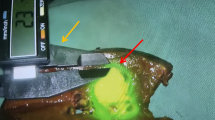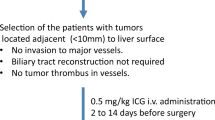Abstract
Background
Although laparoscopic hepatectomy has increasingly been used to treat cancers in the liver, the accuracy of intraoperative diagnosis may be inferior to that of open surgery because the ability to visualize and palpate the liver surface during laparoscopy is relatively limited. Fluorescence imaging has the potential to provide a simple compensatory diagnostic tool for identification of cancers in the liver during laparoscopic hepatectomy.
Methods
In 17 patients who were to undergo laparoscopic hepatectomy, 0.5 mg/kg body weight of indocyanine green (ICG) was administered intravenously within the 2 weeks prior to surgery. Intraoperatively, a laparoscopic fluorescence imaging system obtained fluorescence images of its surfaces during mobilization of the liver.
Results
In all, 16 hepatocellular carcinomas (HCCs) and 16 liver metastases (LMs) were resected. Of these, laparoscopic ICG fluorescence imaging identified 12 HCCs (75 %) and 11 LMs (69 %) on the liver surfaces distributed over Couinaud’s segments 1–8, including the 17 tumors that had not been identified by visual inspections of normal color images. The 23 tumors that were identified by fluorescence imaging were located closer to the liver surfaces than another nine tumors that were not identified by fluorescence imaging (median [range] depth 1 [0–5] vs. 11 [8–30] mm; p < 0.001).
Conclusions
Like palpation during open hepatectomy, laparoscopic ICG fluorescence imaging enables real-time identification of subcapsular liver cancers, thus facilitating estimation of the required extent of hepatic mobilization and determination of the location of an appropriate hepatic transection line.


Similar content being viewed by others
References
Buell JF, Cherqui D, Geller DA, O’Rourke N, Iannitti D, Dagher I et al (2009) The international position on laparoscopic liver surgery: the Louisville Statement, 2008. Ann Surg 250(5):825–830
Edwin B, Nordin A, Kazaryan AM (2011) Laparoscopic liver surgery: new frontiers. Scand J Surg 100:54–65
Ishizawa T, Gumbs AA, Kokudo N, Gayet B (2012) Laparoscopic segmentectomy of the liver: from segment I to VIII. Ann Surg 256:959–964
Ishizawa T, Fukushima N, Shibahara J, Masuda K, Tamura S, Aoki T et al (2009) Real-time identification of liver cancers by using indocyanine green fluorescent imaging. Cancer 115:2491–2504
Gotoh K, Yamada T, Ishikawa O, Takahashi H, Eguchi H, Yano M et al (2009) A novel image-guided surgery of hepatocellular carcinoma by indocyanine green fluorescence imaging navigation. J Surg Oncol 100:75–79
Verbeek FP, van der Vorst JR, Schaafsma BE, Hutteman M, Bonsing BA, van Leeuwen FW et al (2012) Image-guided hepatopancreatobiliary surgery using near-infrared fluorescent light. J Hepatobiliary Pancreat Sci 19:626–637
van der Vorst JR, Schaafsma BE, Hutteman M, Verbeek FP, Liefers GJ, Hartgrink HH et al (2013) Near-infrared fluorescence-guided resection of colorectal liver metastases. Cancer 119:3411–3418
Ishizawa T, Zuker NB, Kokudo N, Gayet B (2012) Positive and negative staining of hepatic segments by use of fluorescent imaging techniques during laparoscopic hepatectomy. Arch Surg 147:393–394
Arita J, Takahashi M, Hata S, Shindoh J, Beck Y, Sugawara Y et al (2011) Usefulness of contrast-enhanced intraoperative ultrasound using Sonazoid in patients with hepatocellular carcinoma. Ann Surg 254:992–999
Takahashi M, Hasegawa K, Arita J, Hata S, Aoki T, Sakamoto Y et al (2012) Contrast-enhanced intraoperative ultrasonography using perfluorobutane microbubbles for the enumeration of colorectal liver metastases. Br J Surg 99:1271–1277
Ishizawa T, Bandai Y, Ijichi M, Kaneko J, Hasegawa K, Kokudo N (2010) Fluorescent cholangiography illuminating the biliary tree during laparoscopic cholecystectomy. Br J Surg 97:1369–1377
Viganò L, Ferrero A, Amisano M, Russolillo N, Capussotti L (2013) Comparison of laparoscopic and open intraoperative ultrasonography for staging liver tumours. Br J Surg 100:535–542
Disclosures
Drs. Kudo, Ishizawa, Tani, Harada, Ichida, Shimizu, Kaneko, Aoki, Sakamoto, Sugawara, Hasegawa, and Kokudo have no conflicts of interest or financial ties to disclose.
Funding/support
This work was supported by grants from the Takeda Science Foundation (Ishizawa), the Kanae Foundation for the Promotion of Medical Science (Ishizawa), and the Ministry of Education, Culture, Sports, Science and Technology of Japan (Ishizawa; Nos. 23689060 and 2324
9067).
Author information
Authors and Affiliations
Corresponding author
Electronic supplementary material
Below is the link to the electronic supplementary material.
Supplementary Video 1 Fluorescence imaging of liver cancers during hepatic mobilization Patient 1 The right liver is mobilized using fluorescence imaging to confirm the exact location of an hepatocellular carcinoma in segment 7. Patient 2 Colorectal liver metastasis is located in segment 1. Although the tumor is exposed on ventral surface of the Spiegel’s lobe, it is identifiable from the dorsal aspect only by using fluorescence imaging. Based on the fluorescence images, the caudate vein is divided and the Spiegel’s lobe is completely mobilized before hepatic transection. (MOV 24918 kb)
Supplementary Video 2 Determination of a hepatic transection line using fluorescence imaging Patient 3 Boundary of a colorectal metastasis located in segment 6 is confirmed by fluorescence imaging, and then minimal hepatic transection line is marked with an electric cautery on the liver surface prior to hepatic transection. (MOV 38108 kb)
Rights and permissions
About this article
Cite this article
Kudo, H., Ishizawa, T., Tani, K. et al. Visualization of subcapsular hepatic malignancy by indocyanine-green fluorescence imaging during laparoscopic hepatectomy. Surg Endosc 28, 2504–2508 (2014). https://doi.org/10.1007/s00464-014-3468-z
Received:
Accepted:
Published:
Issue Date:
DOI: https://doi.org/10.1007/s00464-014-3468-z




